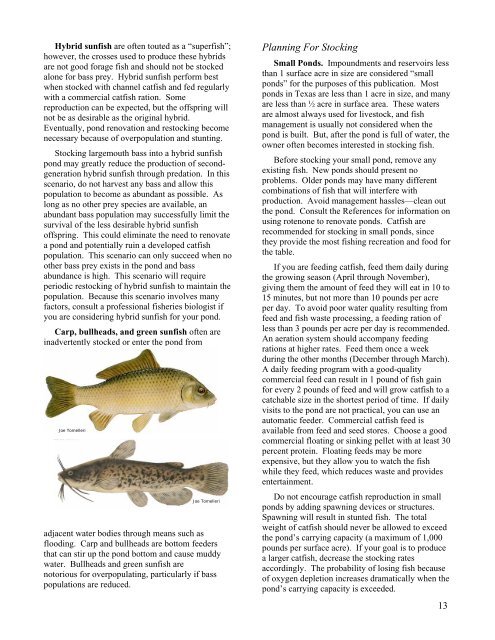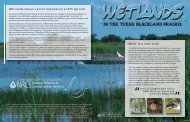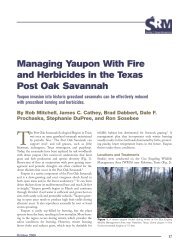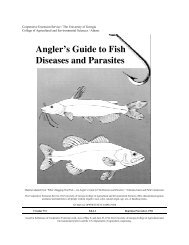Texas Farm Ponds: Stocking, Assessment, and Management ...
Texas Farm Ponds: Stocking, Assessment, and Management ...
Texas Farm Ponds: Stocking, Assessment, and Management ...
Create successful ePaper yourself
Turn your PDF publications into a flip-book with our unique Google optimized e-Paper software.
Hybrid sunfish are often touted as a “superfish”;<br />
however, the crosses used to produce these hybrids<br />
are not good forage fish <strong>and</strong> should not be stocked<br />
alone for bass prey. Hybrid sunfish perform best<br />
when stocked with channel catfish <strong>and</strong> fed regularly<br />
with a commercial catfish ration. Some<br />
reproduction can be expected, but the offspring will<br />
not be as desirable as the original hybrid.<br />
Eventually, pond renovation <strong>and</strong> restocking become<br />
necessary because of overpopulation <strong>and</strong> stunting.<br />
<strong>Stocking</strong> largemouth bass into a hybrid sunfish<br />
pond may greatly reduce the production of secondgeneration<br />
hybrid sunfish through predation. In this<br />
scenario, do not harvest any bass <strong>and</strong> allow this<br />
population to become as abundant as possible. As<br />
long as no other prey species are available, an<br />
abundant bass population may successfully limit the<br />
survival of the less desirable hybrid sunfish<br />
offspring. This could eliminate the need to renovate<br />
a pond <strong>and</strong> potentially ruin a developed catfish<br />
population. This scenario can only succeed when no<br />
other bass prey exists in the pond <strong>and</strong> bass<br />
abundance is high. This scenario will require<br />
periodic restocking of hybrid sunfish to maintain the<br />
population. Because this scenario involves many<br />
factors, consult a professional fisheries biologist if<br />
you are considering hybrid sunfish for your pond.<br />
Carp, bullheads, <strong>and</strong> green sunfish often are<br />
inadvertently stocked or enter the pond from<br />
Joe Tomelleri<br />
Joe Tomelleri<br />
adjacent water bodies through means such as<br />
flooding. Carp <strong>and</strong> bullheads are bottom feeders<br />
that can stir up the pond bottom <strong>and</strong> cause muddy<br />
water. Bullheads <strong>and</strong> green sunfish are<br />
notorious for overpopulating, particularly if bass<br />
populations are reduced.<br />
Planning For <strong>Stocking</strong><br />
Small <strong>Ponds</strong>. Impoundments <strong>and</strong> reservoirs less<br />
than 1 surface acre in size are considered “small<br />
ponds” for the purposes of this publication. Most<br />
ponds in <strong>Texas</strong> are less than 1 acre in size, <strong>and</strong> many<br />
are less than ½ acre in surface area. These waters<br />
are almost always used for livestock, <strong>and</strong> fish<br />
management is usually not considered when the<br />
pond is built. But, after the pond is full of water, the<br />
owner often becomes interested in stocking fish.<br />
Before stocking your small pond, remove any<br />
existing fish. New ponds should present no<br />
problems. Older ponds may have many different<br />
combinations of fish that will interfere with<br />
production. Avoid management hassles—clean out<br />
the pond. Consult the References for information on<br />
using rotenone to renovate ponds. Catfish are<br />
recommended for stocking in small ponds, since<br />
they provide the most fishing recreation <strong>and</strong> food for<br />
the table.<br />
If you are feeding catfish, feed them daily during<br />
the growing season (April through November),<br />
giving them the amount of feed they will eat in 10 to<br />
15 minutes, but not more than 10 pounds per acre<br />
per day. To avoid poor water quality resulting from<br />
feed <strong>and</strong> fish waste processing, a feeding ration of<br />
less than 3 pounds per acre per day is recommended.<br />
An aeration system should accompany feeding<br />
rations at higher rates. Feed them once a week<br />
during the other months (December through March).<br />
A daily feeding program with a good-quality<br />
commercial feed can result in 1 pound of fish gain<br />
for every 2 pounds of feed <strong>and</strong> will grow catfish to a<br />
catchable size in the shortest period of time. If daily<br />
visits to the pond are not practical, you can use an<br />
automatic feeder. Commercial catfish feed is<br />
available from feed <strong>and</strong> seed stores. Choose a good<br />
commercial floating or sinking pellet with at least 30<br />
percent protein. Floating feeds may be more<br />
expensive, but they allow you to watch the fish<br />
while they feed, which reduces waste <strong>and</strong> provides<br />
entertainment.<br />
Do not encourage catfish reproduction in small<br />
ponds by adding spawning devices or structures.<br />
Spawning will result in stunted fish. The total<br />
weight of catfish should never be allowed to exceed<br />
the pond’s carrying capacity (a maximum of 1,000<br />
pounds per surface acre). If your goal is to produce<br />
a larger catfish, decrease the stocking rates<br />
accordingly. The probability of losing fish because<br />
of oxygen depletion increases dramatically when the<br />
pond’s carrying capacity is exceeded.<br />
13









